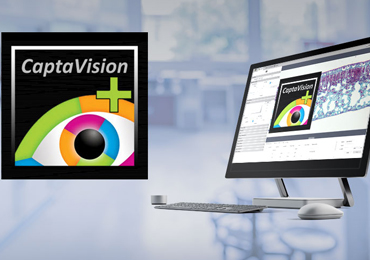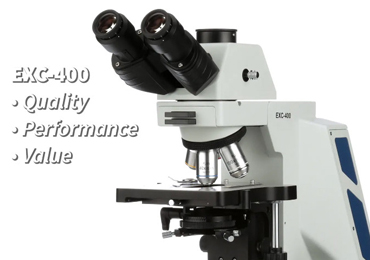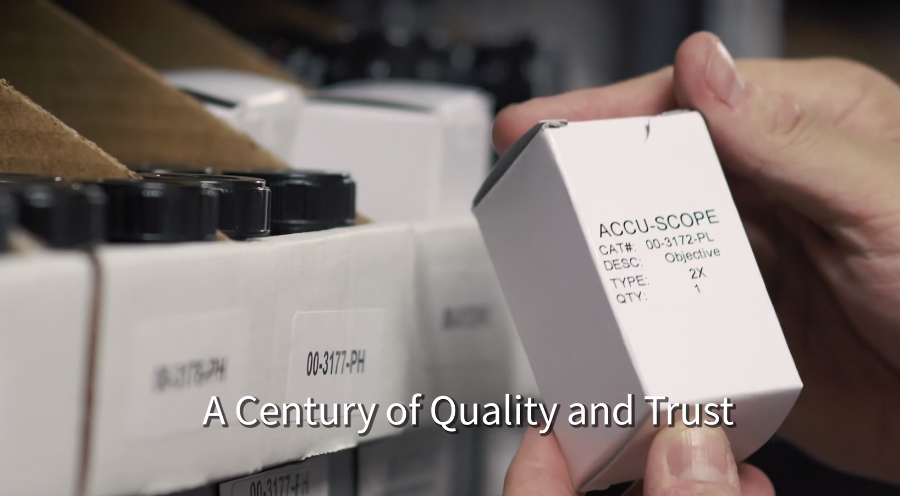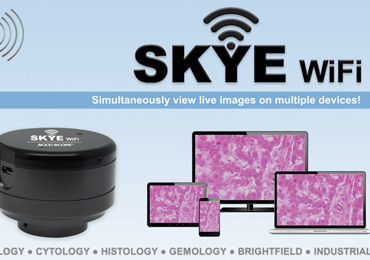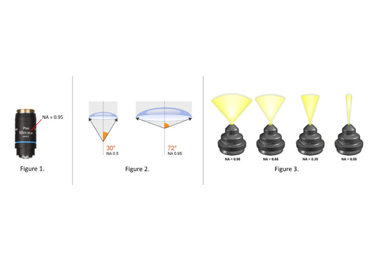
We are often asked to recommend the objectives for a microscope. The objective sits closest to the specimen, and is an integral component of the microscope and crucial to delivering an acceptable image of the specimen. All the information you need to know is written right on the barrel of the objective: flatness correction, magnification, Numerical Aperture, immersion medium, optical path design, and whether to use with or without a coverglass. One of the more confusing criteria, however, is Numerical Aperture. In this brief article, I’ll attempt to demystify Numerical Aperture, and how to get the most out of it.
Very simplistically, Numerical Aperture (“NA”) is the ability of an objective lens to collect light, and it’s written on the objective just after the magnification (Figure 1). A higher angle of light = a higher NA (see Figure 2). Additional light means more information, which means better resolution. So the higher the NA, the better the optical resolution. But it’s not as easy as moving closer to the specimen.
In order to take maximum advantage of the objective’s NA, the condenser should be adjusted to match – this adjustment is one step of Köhler Alignment. Thankfully most condensers have an aperture adjustment for this purpose (see Figure. 3). Since the NA changes every time you change objectives on a microscope (objectives with higher magnification typically have higher NA), the condenser should also be adjusted – this is literally a 2 second adjustment, and can make a HUGE difference in the image and resolution. We’ll review Köhler Alignment in another article.
Let’s say that two objectives have the same magnification but different NAs. The one with higher NA will typically cost more. And to get an NA of 1.0 or higher, you’ll need an immersion objective that requires some other medium than air (typically oil, water, glycerin, or silicon oil) to be placed between the objective and the coverglass above the specimen. This additional medium bends (“refracts”) more light (therefore, more information) into the objective lens, thereby increasing resolution. Note that immersion objectives are specifically designed for particular immersion media, and no objective should be used with an immersion medium for which it was not intended – – this will void any warranty, and you won’t get the results you hoped for.
Numerical Aperture = n sin θ
where n is the refractive index of the medium between the objective and the coverglass, and θ is the ½ angle of light collected by the objective lens (refer to Fig. 2). Air has a refractive index of approximately 1.0 and typical immersion oil has a refractive index of 1.51. You can see how oil is needed for an NA > 1.0. Therefore in order to have an NA greater than 1.0, you’ll need to use an immersion medium with a refractive index higher than 1.0.
Objectives of the same magnification but different NAs will give different results. A higher NA objective, when the microscope is properly adjusted, will have higher resolution and deliver a crisper image. The trade off is that the depth of focus becomes shallower as resolution increases. So if you want to have more of the specimen in focus, you may want to choose an objective with lower NA.
Finally, higher NA doesn’t necessarily translate into a better image. Other optical qualities must be considered (e.g. correction for field curvature, chromatic aberration, spherical aberration, etc.), all topics for another time.
Thanks for reading!
